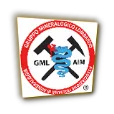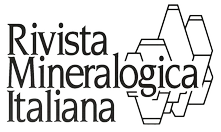Abstract 2019
Rivista Mineralogica Italiana > Abstract Articoli
| Abstract ITALIAN MINERALOGICAL MAGAZINE nr. 1-2019 | |||||||||
In 1998 the author, thanks to the indications given by Giordano Cavallari and Maria Siena, started collecting in a small abandoned travertine quarry, in the area of the thermal springs of San Giovanni, close to the village of Rapolano Terme (Siena), nice globular calcite aggregates. The occurrence is represented by tabular sub-horizontal cavities within travertine, whose depo- sition has been related to the presence of some nearby thermal springs. Calcite here forms columnar aggregates with a diameter of about 3 to 4 centimeters, and length up to 20 centimeters. Such columns are all perpendicular to the base and, in the cavities, they mostly grew downward from the roof. The calcite color ranges from pale yellow to pale orange and occasionally the tip of the longest columns have a sharp tran- sition to more saturated brown-red colour. At present, collecting at this site may be still possible but unfortunately a few years ago the place which provided for the best samples was buried by dump material resulting by the demolition of some nearby house. | |||||||||
CLASSIC MINERAL SPECIMENS FROM THE EVAPORITIC ORE DEPOSITS IN THE CENTRAL SICILY | The wide sulfur-bearing basin of cen- tral Sicily produced outstanding mineral specimens during the late 19th and early 20th Century, when hundreds of mines were active. Samples such as sulfur, celestine, aragonite, calcite, gypsum, hauerite, melanophlogite and baryte enriched the museums all over the world and a lot of private collections. Famous mines such as Cozzo Disi, Cianciana, Giumentaro, Floristella, Gessolungo, La Grasta provided beautiful minerals, but the definitive closure of Sicilian sulfur mines, which took place in the last years of 1900, put an end to the findings of these beauti- ful specimen. | ||||||||
THE ANTIMONY ORE DEPOSIT OF REMENTIL (PERGINE VALSUGANA, TN). MINERALOGICAL NEWS AND MINING HISTORY | The mining site of Rementil is located 4 km NE to Pergine Valsugana and it is known for an antimony mineralization (mainly berthierite) hosted in the middle-lower part of the permian volcanic series of the Gruppo Vulcanico Atesino. The mining activity took place between the end of the nine- teenth century and the 1930s, with the excavation of three short tunnels Compared to what is known in the mineralogical literature, the recent re- investigation of the site has highlighted the presence of four new sulphosalts for the locality, i.e. jamesonite, zinkenite and two minerals of the plagionite group: semseyite, not yet documented in Trentino Alto Adige region, and fülöppite, a first description for Italy. | ||||||||
HEMATITE AND CHLORITIZED QUARTZ FROM CARRARA MARBLE QUARRIES | The quarry n. 6 “Piastriccioni C”, known among quarrymen as “The whale”, is located in the Pescina-Boc- canaglia marble basin, the western most among those present in the Carrara district. In this locality, some common minerals were collected in unusual specimens for the marble cavities. In fact, aesthetic groups of tabular crystals of hematite (in the “iron rose” variety) and chloritized quartz were recently collected. | ||||||||
TANTALAESCHYNITE-(Y) FROM CROPPOLA QUARRY, MONTECRESTESE (VCO) | In 2014 the works at the Croppola quarry, municipality of Montecres- tese, Antigorio valley, exposed pegmatitic dikes hosting centimetric crystals of tantalaeschynite-(Y) associated with dark blue beryl, black tourmaline, garnet, muscovite and smoked quartz. | ||||||||
Abstract ITALIAN MINERALOGICAL MAGAZINE nr. 2-2019 | |||||||||
THE SAN LUGANO MINE (CARANO, FIEMME VALLEY, TN, ITALY). TYPE LOCALITY OF FIEMMEITE AND INTERESTING COPPER- URANIUM MINERALIZATION | Collapsed adits of the ancient mine upstream Passo di San Lugano in the County of Carano (lower Fiemme Valley) are known for their azurite and malachite specimens, found in basal levels of the Val Gardena Sandstone (upper Permian). In the last five years the study of Cu-U typical mineraliza- tions in coalified woods leads to the discovery of three new copper-oxa- late phases: moolooite, middlebackite –previously found only in the type locality Iron Monarch quarry, Middle back Range, Australia and approved in April 2016 (IMA-2015-115) and the new mineral fiemmeite, approved in 2018 (IMA-2017-115) and named by the authors with reference to the discovery location (Fiemme Valley). This study describes these mineralogical findings and gives a new detailed description of the San Lugano mining site and of the more than 30 mineralogical phases associated to copper oxalates, some of which are uncommon (bariopharmacosiderite, parnauite, plumbojarosite, tyrolite, zálesíite). | ||||||||
HISTORIC FOUND OF HYALINE QUARTZ IN RIO RONI, UPPER FORMAZZA VALLEY (VERBANO-CUSIO- OSSOLA) | The events related to the important discovery of hyaline quartz from Rio Roni began in the summer of 1971 when, just above the village of Riale, in the Rio Röni stream, one of the authors (Giovanni Gaspari) found a very clear fragment of quartz crystal. During five years of researches, more than ten fissures lined with quartz crystals were found. These cavities measured between 3 and 8 metres in length and 2 and 4 metres in height. The best hyaline quartz crystals were located in the central portion of these fissures. When the cavity reached the bottom, quartz crystals up to 10 cm in length and 3 cm in diameter were also collected. | RHODONITE AND “CLINOTHULITE” FROM VALMALENCO | Rhodonite and “clinothulite” from Malenco valley are part of the mineralogical heritage of Lombardy region and were appreciated as a gemological material for their pleasant color and their workability since the last years of the last century. These two minerals, pink in color, have a fair commercial value being very appreciated by the gemological market for the pleasantness of the color and neness of the grain which, together with their compactness, allows the realization of valuable jew- elery and objects. | ||||||
BOLOGNA MINERAL SHOW THE THEMATIC EXHIBITS OF THE 50TH ANNIVERSARY | The 50th Bologna Mineral Show was held on March 8-13, 2019 in Casalecchio di Reno (BO). The thematic special exhibits are among the most important and appreciated features of the show, and this year, on occasion of the 50th anniversary, they have been particularly rich and important. The first exhibit concerned the gold, focusing on the specimens found in the classic locality of Brusson, Ayas Valley (AO), and gold nuggets found in several rivers in Piedmont. An additional show case was dedicated to a few representative specimens of native elements. The central part of the special exhibits was dedicated to the minerals from Carrara and the Apuan Alps marbles. 15 showcases presented an exceptional selection of specimens from private collections and from the Pisa University Museum (located in Calci). Most of the specimens have been photographed and documented in the new book “MINERALS from MARBLES of CARRARA and the Apuan Alps”. Additional exhibits included the red color in minerals, mineral fakes, and the Bagnone meteorite. | ||||||||
Abstract ITALIAN MINERALOGICAL MAGAZINE nr. 3-2019 | |||||||||
HOPPER QUARTZ FROM PORRETTA TERME | The area of Porretta Terme, located in the Appenines close to Bologna, is famous since the nineteenth century for the occurrence of remarkable skeletal quartz crystals. These crystals belong to the classics of the Italian mineralogy because of their beauty and of the great amount of studies carried out by important Italian mineralogists such as Luigi Bombicci and Luigi Gambari. The size of the crystals varies from few millimetres to nearly 40 cm. They occur within clefts that crosscut the sandstone rocks. The main characteristics of these crystals are the presence of enhdros inclusions and the hoppered faces often filled with clay. The so called “tramogge” are cavities or geometrical voids that formed mostly in the inner parts of the main crystal faces; they represent the preferred accumulation of crystalline material along the edges of the crystal. Their origin seems to be connected to rapid growth stages and oversaturation conditions caused by quick changes in the parameters conditioning the mineralizing fluids. The historical collection of Luigi Bombicci, hosted in the homony- mous museum of the University of Bologna, includes a great number of historical samples of hopper quartz from Porretta that have been studied and catalogued by him during the nineteenth century. | ||||||||
ALPINE PEGMATITES OF BODENGO VALLEY, CHIAVENNA (SO) | On the orographic left along the Mera river valley looking towards Chiaven- na, the Bodengo valley and the two lateral ones, Garzelli and Soè, are wild Alpine areas, rich in pegmatitic veins, where collecting of minerals allows you to be immersed in a still almost pristine natural environment. Start- ing from the 80s, the Bodengo valley has been mainly visited by local mineral collectors and several dikes were dug in search for large beryl crystals. In the pegmatitic veins, which host miarolitic cavities, excellent samples of beryl (variety aquamarine), smoky quartz crystals, microcline, almandine garnet, black schorl, as well as uncom- mon accessory minerals such as iron and manganese phosphates, bavenite, bertrandite, milarite, columbite-Fe and tapiolite-Fe were also collected. Bodengo valley is the only known Alpine locality of the Central Alps, to- gether with the Adamello area, were miarolitic cavities were found so far. This locality has still large potential for new discoveries of pegmatite cav- ities hosted within large pegmatites which cross-cut the hosting rocks for hundreds of meters in the Garzelli and Soè valleys. | ||||||||
THE ALPINE PEGMATITES OF LOWER ISORNO VALLEY, MASERA (VB) | Isorno valley is a narrow incision that branches off just north of Antigorio valley. The first findings of pegmatite blocks date back to the devastating flood on the night of August 7, 1978 which occurred in this area. Beginning in the mid-1990s, the reconstruction of a hydroelectric plant in a cave on the left side of the valley was completed. During these works an access road was built and a number of pegmatite blocks were discovered. In these blocks we can find the classic minerals of Alpine pegmatites including blue, opaque beryl crystals, few centimeters in size, black tourmaline, in rather elongated prismatic crystals, sometimes terminated and with shiny surfaces, several cen- timeters tall, garnets in brown-reddish crystals up to two centimeters across, orange-red in color when enclosed in quartz. Uncommon minerals include yellow microcrystals of uranium-bearing phosphates and brownish opaque prismatic zircon crystals, measuring several millimeters across. | ||||||||
Abstract ITALIAN MINERALOGICAL MAGAZINE nr. 4-2019 | |||||||||
THE FLUORITE OF TERMINI IMERESE. FINDINGS AT POGGIO BALATE IN THE SAN CALOGERO MASSIF (NORD – WESTERN SICILY). | The Termini Imerese area in the prov- ince of Palermo, well known for the beauty of its landscapes, has been also known by collectors for about 50 years for the remarkable occurrence of fluorite crystals and baryte. In particular, on the hill of Poggio Balate, in the lower part of the west- ern slope of the San Calogero Mount, excellent findings of cubic crystals of fluorite have been carried out several times. The colour of the crystals is mostly green and more rarely violet. Often fluorite crystals are associated with white baryte crystal aggregate. However, even in other outcrops in the same area of Poggio Balate, several exceptional fluorite specimens have been found, making the area of Termini Imerese a unique mineralogical locality in Sicily. | ||||||||
SCEPTER CELESTINE OF CASTELGOMBERTO (VI). NEW INFORMATION FROM A CLASSIC LOCALITY OF THE VENETO MINERALOGY | Celestine of the Vicenza province, occurring in the Oligocene formation of Calcareniti di Castelgomberto, has been known and well described in the mineralogical literature since more than two centuries. Celestine occurs in cavities within the masses of fossil corals up to several decimetres wide, where it forms crystals of with various habits of the size up to 10 cm. Since the morphological aspects of the Castelgomberto celestine have been widely treated by the authors in a recently published book, this article focuses mainly on the scepter celestine, a habit rather unusual for this mineral. | ||||||||
UNIQUE SCEPTER QUARTZ IN THE SKARN CAVITIES IN THE CASTRUCCI VALLEY (MASSA MARITIMA, GR) | In recent years, in the area of the Fenice Capanne mine (Massa Marittima, GR), large cavities were discovered lined with amethystine or colorless quartz crystals, exceptionally up to 20 cm, with scepter shaped morphologies of remarkable aesthetic level. The area of the findings is located north of the main Fenice Capanne orebody. It is indicatively located in the Cas- trucci valley, a tributary of Fosso dei Noni where hedenbergite-epidote skarn bodies crop out hosted in the “argille scagliose” formation. Usually the most beautiful cavities are located at the roof of altered hedenbergite skarn masses. | ||||||||
ANATASE CRYSTALS INCLUDED IN QUARTZ FROM SOVRANA MOUNTAIN (SP) | The Sovrana mountain is a hill of 339 meters located in front of the famous Monte Nero mine in the province of La Spezia, well known for the finest inesite samples found in Italy. This paper reports the finding of several samples of anatase, in individuals up to 2 mm, sometimes included in quartz crystals, in quartz veins embedded in the Diaspri Formation. Brookite has also been found although it is much rarer. | ||||||||
NEW ITALIAN MINERALS. APPROVALS 2018 | Nine new mineral species from Ital- ian type localities were approved by the IMA-CNMNC in 2018. Two of the new minerals, sbacchiite and ferri-mottanaite-(Ce), were first de- scribed from Italian volcanic complexes. The former is a Ca-Al fluoride found in fossil fumaroles from Vesu- vius, whereas the latter is a new member of the hellandite group, identified in sanidinite ejecta collected at Tre Croci (Vetralla, Vico Volcanic Complex). Four new species were iden- tified from the Mn-ore deposits of Liguria, Piedmont, and Aosta Valley. Demagistrisite and bonacinaite (the latter being the first known Sc-arse- nate) were found in the Cerchiara and Varenche mines, respectively; armellinoite-(Ce) and ferriakasakaite-(Ce) are two new REE-minerals from Montaldo di Mondovì and Monte Maniglia, respectively. Two new mineral species were identified from Tren- tino-Alto Adige: fiemmeite, from Fiemme Valley, and monteneveite, a new garnet-supergroup mineral from the Monteneve mine. Finally, jahnsite-(MnMnFe) is a new addition to the mineralogy of Piona pegmatites. | ||||||||


















